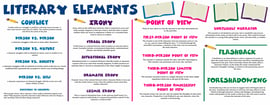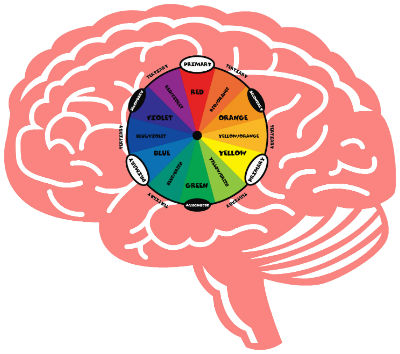By: Melissa Hughes, Ph.D. on July 6th, 2017
The Neuroscience of Color
Featured Topics: Differentiated Instruction | Featured Topics: Lessons and Activities | VariQuest Tools: Perfecta 3600
 Color is believed to be the most important visual experience to human beings. More specifically, significant research has been conducted in recent years exploring the function of color as a powerful channel to cognition and memory.
Color is believed to be the most important visual experience to human beings. More specifically, significant research has been conducted in recent years exploring the function of color as a powerful channel to cognition and memory.
Marketers have known for years how effective color can be with brand recognition and attitudes consumers form about products and companies. For example, a 2004 marketing study found that color increases brand recognition and influences purchasing decisions by up to 80%.
Consider the success of Heinz Squirt Blastin’ Green ketchup in 2000. While Heinz has since discontinued this product, more than 10 million bottles were sold in the first seven months resulting in $23 million in sales – the highest sales increase in the brand’s history.
Advertisers also know that color is one of the most important elements in capturing readers’ attention and influencing their attitude toward the product. Studies indicate that colored advertisements are read up to 42% more often than black and white ads.
The same principle applies in the classroom. The role played by color in enhancing our level of attention is undisputable. Moreover, research shows that the use of color in the classroom improves readership by 40%, reading comprehension by 73% and overall learning by 55-78%. Clinical intervention for students with dyslexia using color have been proven to be effective in reducing difficulties in reading. Color has also been used to help autistic students. In fact, autistic students who used a colored overlay showed an improvement of reading speed up to 35% compared to autistic students who did not use the overlay.
These learning gains are largely attributed to way the brain processes color. Color connects neural pathways and integrates the 12 intelligences, enabling learners to construct meaning and make deeper cognitive connections with content. Color also creates a physiological and emotional response that impacts learning. Every color has a specific wavelength and each of these affect our body and brain in a different way.
Cool colors like blues, greens, and purples invoke a state of calm, relaxation and tranquility. When we feel relaxed, we tend to be more explorative and creative processes flow more naturally.
Warm colors such as red and orange, on the other hand, stimulate the brain and improve focus, memory and performance. Clinical studies show that the color red influences memory performance by increasing our attentional level and evoking an emotional arousal to the content.
Results from a 2009 study conducted by Ravi Mehta and Rui Zhu at the University of British Columbia confirmed the impact of red and blue on brain function. They found that if the task required vigilant attention such as memorization or comprehension, red is more effective. However, if the task requires creativity and imagination, the color blue opens neural pathways and enhances those cognitive processes.
Color psychologists maintain that orange stimulates critical thinking and pink has a calming influence and reduces heart rate. Some teachers have experimented with this by covering students’ desks with orange and pink paper during exams.
Additional research has explored the impact of color combination has on memory. A higher level of color contrast attracts more attention and better visibility which influences memory retention.
Color theory is a science. Studying how colors affect people, either individually or as a group, is a billion-dollar business for brands that want to capture greater market share. But the fact that color impacts learning and memory is indisputable and an inexpensive instructional strategy.
Here are a few tips to help you put color to use in your learning experiences without spending a billion dollars:
Student Notes: Encourage students to use colored pencils or pens when they take notes. A contrasting three-color system can be an effective formula. One color is used for key concepts or important vocabulary words, another color is used for supporting details and the third color represents their own thoughts and ideas. Highlighters and transparent colored tape or flags can also be used to draw attention to key words.
 Anchor Charts: Use the same type of three-color system when creating anchor charts. This enables students to visually discriminate between main ideas and supporting details as you introduce new information. Choose high-contrasting colors for the maximum effect.
Anchor Charts: Use the same type of three-color system when creating anchor charts. This enables students to visually discriminate between main ideas and supporting details as you introduce new information. Choose high-contrasting colors for the maximum effect.
 Classroom Visual Aids: Images and colored text used in visual aids will significantly increase readership and students’ ability to recall them later. Draw attention to titles, labels, and key words by using colors that contrast with the bulk of the text.
Classroom Visual Aids: Images and colored text used in visual aids will significantly increase readership and students’ ability to recall them later. Draw attention to titles, labels, and key words by using colors that contrast with the bulk of the text.
Graphic Organizers: Using color to group categories of information as well as to identify the connections between ideas gives students an additional strategy to see contextual relationships within the content.
However you decide to incorporate the science of color into your classroom, the VariQuest Perfecta® STP Poster Printer can help. Click here to learn more about how it can help you differentiate instruction via colorful infographics, engaging posters, spirited banners, and more!
About Dr. Hughes
 Dr. Melissa Hughes is the founder of The Andrick Group and the author of the book, Happy Hour with Einstein. She develops and delivers professional development opportunities for educators across the country based upon whole-brain thinking and learning for deeper cognition and increased student engagement.
Dr. Melissa Hughes is the founder of The Andrick Group and the author of the book, Happy Hour with Einstein. She develops and delivers professional development opportunities for educators across the country based upon whole-brain thinking and learning for deeper cognition and increased student engagement.

